Dive into Relaxation with These Stunning Sea Creature Pictures
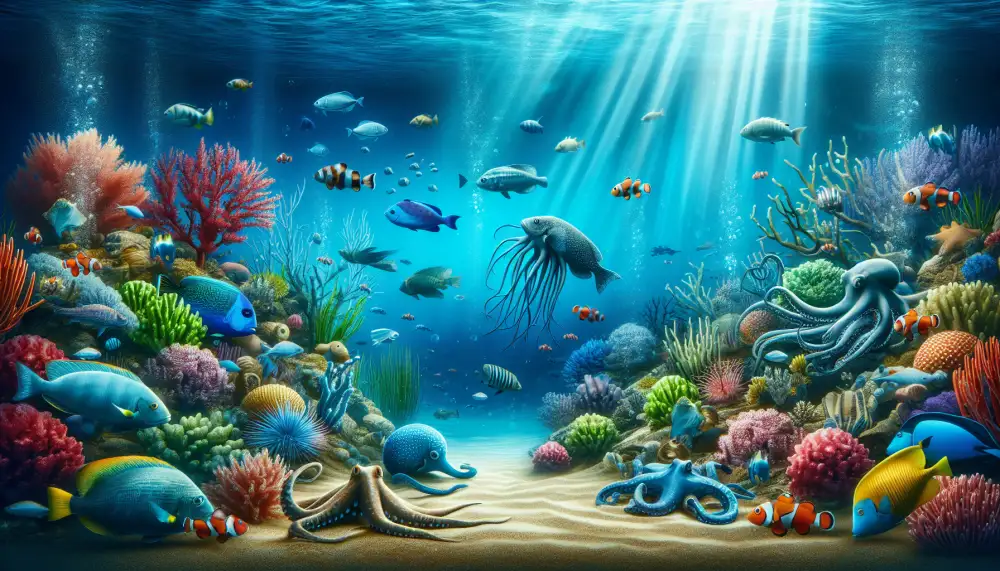
Habitat
The ocean, a vast and mysterious realm, provides a diverse range of habitats for countless marine creatures. From sun-drenched surface waters to the deepest, darkest trenches, each habitat presents unique challenges and opportunities for the animals that call it home.
Coral reefs, often called the "rainforests of the sea," teem with life. These vibrant ecosystems, built by tiny animals called coral polyps, provide shelter, food, and breeding grounds for a dazzling array of fish, invertebrates, and other marine life. Shallow, warm waters with plenty of sunlight are essential for coral growth, making them particularly vulnerable to the impacts of climate change.
Moving from the tropics to colder waters, kelp forests dominate. These underwater forests, formed by towering kelp reaching towards the surface, provide a rich habitat for a variety of species. Sea otters, seals, and a variety of fish navigate the kelp stalks, while invertebrates cling to their surfaces, finding food and protection within this unique ecosystem.
The open ocean, also known as the pelagic zone, presents a different set of challenges. Vast and seemingly empty, it is home to some of the ocean's most impressive creatures. Sharks, whales, and tuna roam these waters, relying on their speed and agility to hunt prey and traverse long distances.
Venturing deeper, we reach the twilight zone, where sunlight fades and the pressure increases. Here, bioluminescent creatures, like anglerfish and jellyfish, create their own light to attract prey and communicate in the darkness. This mysterious region is still being explored, and scientists believe it holds a wealth of undiscovered species.
Finally, the abyssal zone, the deepest part of the ocean, is a realm of perpetual darkness and immense pressure. Despite the harsh conditions, life persists. Creatures here have adapted to survive on the ocean floor, relying on chemosynthesis, a process that uses chemicals from hydrothermal vents, rather than sunlight, as a source of energy.
Social behavior
Observing marine animals in their natural habitat reveals fascinating social behaviors. Some species are solitary, preferring to live alone, while others form complex social structures.
Whales, such as dolphins and orcas, are highly social animals, living in pods that can range from a few individuals to hundreds. These pods communicate using a complex system of clicks, whistles, and body language. They cooperate to hunt, raise their young, and defend themselves from predators.
Fish often form schools for protection, with thousands or even millions of individuals swimming together in a synchronized manner. This behavior makes it difficult for predators to single out individuals, increasing the chances of survival for the group.
Seals and sea lions are known for their playful nature and often congregate in large groups called colonies. These colonies provide safety in numbers, particularly during breeding season when pups are vulnerable.
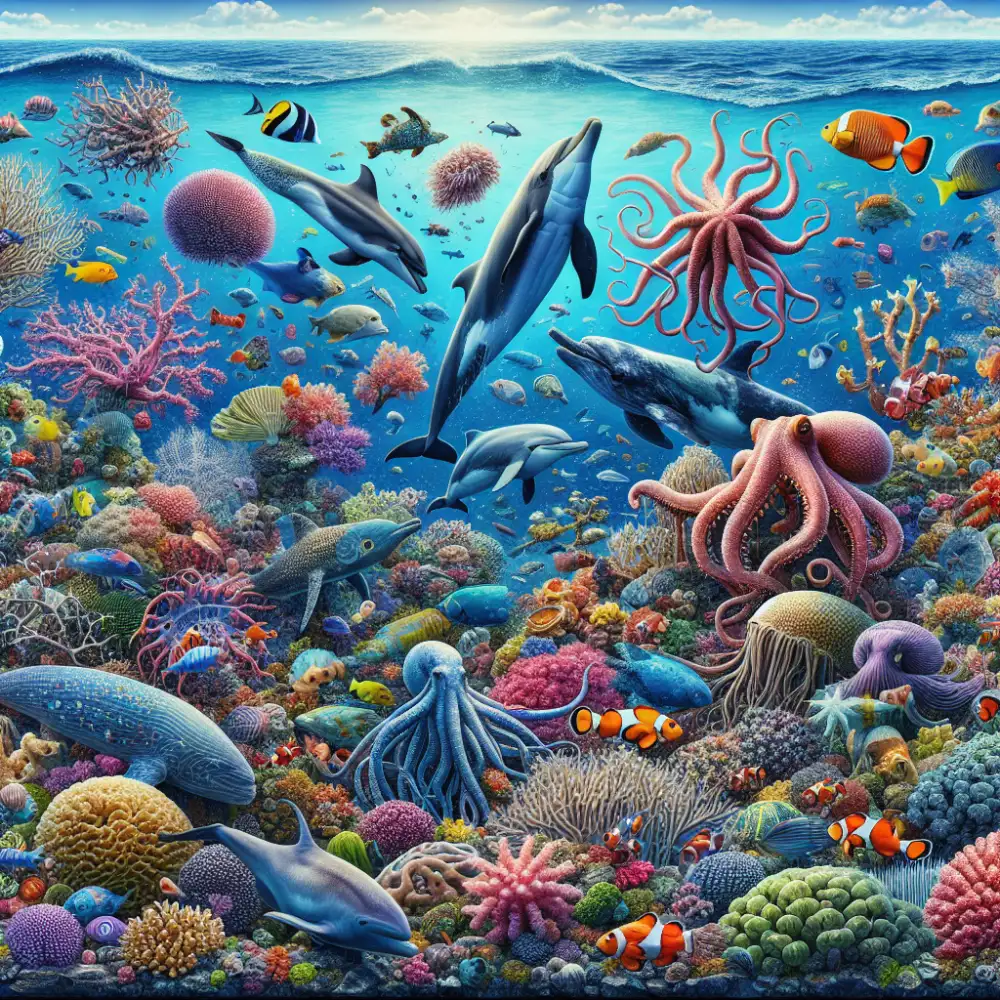
Crustaceans, such as lobsters and crabs, exhibit a range of social behaviors. Some species are territorial and aggressively defend their shelters, while others engage in complex courtship rituals.
Cephalopods, including octopuses, squid, and cuttlefish, are generally solitary creatures. However, some species exhibit remarkable intelligence and communication skills, using color changes and body patterns to signal their intentions to rivals or potential mates.
The social behavior of marine animals is crucial for their survival and reproduction. By studying these interactions, we gain a deeper understanding of the intricate web of life in our oceans.
Diet and feeding
The marine environment teems with a fascinating array of creatures, each with unique dietary needs and feeding strategies. From microscopic plankton to colossal whales, the way these animals obtain and consume food is a testament to their incredible adaptations.
Many marine animals, including baleen whales, sharks, and some fish species, are carnivores, meaning they primarily consume other animals. Baleen whales, despite their massive size, feed on tiny crustaceans called krill. They gulp enormous mouthfuls of water, filtering out the krill using baleen plates in their mouths. Sharks, on the other hand, are apex predators with sharp teeth for tearing flesh. Their diet varies depending on the species, but many consume fish, seals, and other marine mammals.
Herbivorous marine animals, such as manatees and sea turtles, graze on algae and seagrass. These gentle giants spend a significant portion of their day consuming large quantities of plant matter to sustain their large bodies.
Omnivores, including many crustaceans and some fish species, have a more diverse diet, consuming both plants and animals. They play a vital role in maintaining balance within their ecosystems. For instance, crabs scavenge on dead animals and also consume algae, contributing to nutrient recycling.
Detritivores, such as sea cucumbers and some worm species, play a crucial role in the marine food web. They feed on decomposing organic matter, breaking it down and releasing nutrients back into the ecosystem.
Filter feeders, including clams, oysters, and sponges, obtain their food by filtering microscopic organisms and organic particles from the water. These animals play a vital role in water clarity and nutrient cycling.
The feeding strategies employed by marine animals are as diverse as the animals themselves. Some, like the humpback whale, use bubble-net feeding, where a group of whales work together to encircle prey with a net of bubbles, forcing them into a tight ball for easier consumption. Others, like the octopus, are ambush predators, using camouflage to blend into their surroundings and snatch unsuspecting prey with their tentacles.
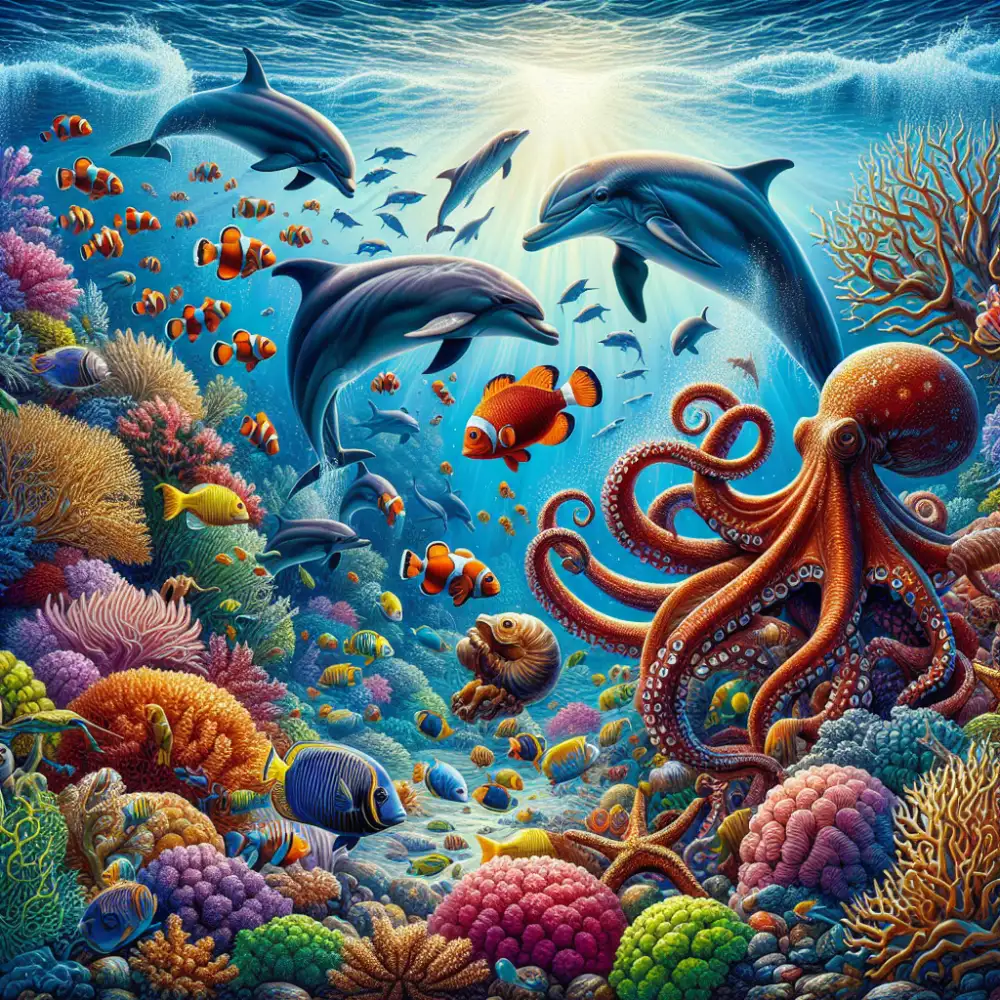
Understanding the diet and feeding habits of marine animals is crucial for conservation efforts. By studying their feeding patterns, scientists can gain insights into the health of marine ecosystems and identify potential threats to these delicate food webs.
Reproduction strategies
The vastness of the ocean conceals a stunning array of reproductive strategies. Unlike terrestrial animals, marine creatures face unique challenges in their quest to procreate. The sheer volume of water necessitates specific adaptations to ensure the survival of their offspring.
Broadcast spawning is a common strategy employed by many marine invertebrates and some fish species. They release massive quantities of eggs and sperm into the water, relying on chance for fertilization. Corals, for example, participate in synchronized spawning events, creating a spectacular underwater blizzard of reproductive cells. While this method is energy efficient, it results in high offspring mortality.
Other marine animals, like seahorses, engage in more intimate reproductive dances. Male seahorses receive eggs from females and fertilize them in their specialized brood pouches. This unusual role reversal highlights the diversity of parental care in the ocean. Sharks, on the other hand, exhibit internal fertilization, with some species laying eggs while others give birth to live young.
Whales, the gentle giants of the ocean, engage in elaborate courtship rituals that can include vocalizations and physical displays. After a gestation period of almost a year, female whales give birth to a single, massive calf. These calves rely on their mothers for milk and protection during their vulnerable early years.
Sea turtles undertake incredible journeys to return to the same beaches where they hatched to lay their own eggs. Under the cover of darkness, females dig nests in the sand and deposit dozens of eggs. The hatchlings face a perilous dash to the sea, evading predators and braving the crashing waves.
From the vibrant coral reefs to the deep ocean abyss, the reproductive strategies of marine animals are as diverse as the creatures themselves. These adaptations, honed over millennia, ensure the continuation of life in our planet's most expansive habitat.
Migration patterns
The vastness and fluidity of the ocean allow for some truly epic migrations. Whales are champion travelers. Humpback whales, for instance, hold a record. They journey thousands of miles from their nutrient-rich, polar feeding grounds to warmer, tropical waters to breed and give birth. These journeys are dictated by the availability of food and suitable breeding conditions. Leatherback sea turtles undertake incredible migrations, traveling across entire ocean basins to reach their nesting beaches. These journeys are often fraught with danger, as they must navigate treacherous currents, avoid predators, and contend with human-made obstacles like fishing gear. Gray whales are another species known for their impressive migrations. They travel from their Arctic feeding grounds to warmer waters off the coast of Mexico to give birth. These migrations are a testament to the incredible endurance and navigational abilities of these marine creatures. Understanding migration patterns is crucial for conservation efforts. By identifying important feeding and breeding areas, we can better protect these animals and ensure their survival. Satellite tagging and photo identification are just two of the methods used by scientists to track these incredible journeys and unravel the mysteries of the underwater world.
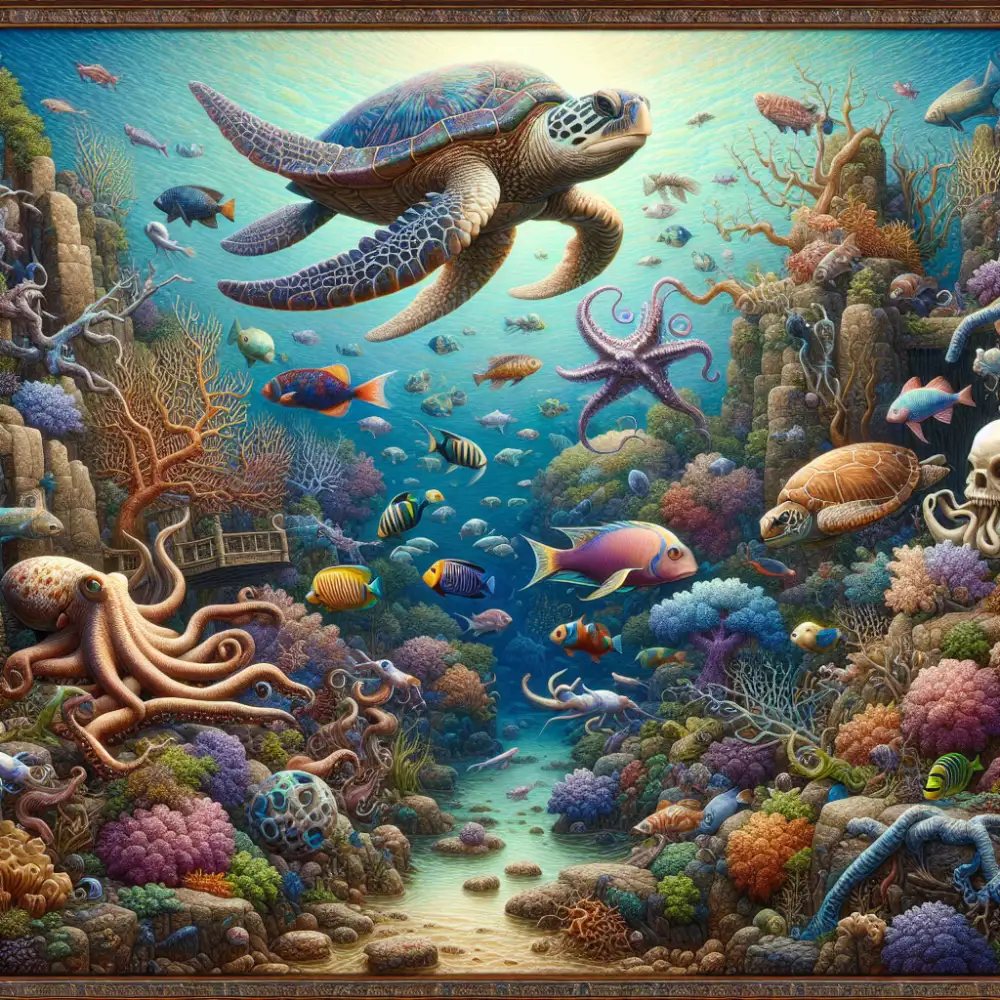

Adaptations to ocean life
Marine animals have evolved a fascinating array of adaptations to thrive in the vast and challenging ocean environment.
Streamlined Bodies for Effortless Movement
Many marine animals, like dolphins, sharks, and tuna, have sleek, streamlined bodies that reduce drag and allow them to move through the water with incredible speed and agility. This adaptation is crucial for chasing prey, escaping predators, and navigating currents.
Breathing Underwater: Gills and Beyond
Unlike terrestrial animals that breathe air with lungs, marine animals have evolved specialized respiratory systems to extract oxygen from the water. Fish, for example, possess gills—highly efficient organs that filter dissolved oxygen from the water as it flows over them. Marine mammals, such as whales and dolphins, still need to breathe air and have developed adaptations like blowholes located on top of their heads, allowing them to take in air while minimizing time spent at the surface.
Staying Afloat: Buoyancy Control
Maintaining buoyancy is crucial for marine animals, allowing them to conserve energy and stay at the desired depth. Some animals, like sharks, rely on their oil-filled livers to provide lift. Others, such as bony fish, have swim bladders—gas-filled sacs that they can adjust to control their buoyancy.
Sensing the Surroundings: Specialized Senses
The ocean can be a sensory-challenging environment, with limited visibility and varying pressures. Marine animals have developed remarkable adaptations to navigate and perceive their surroundings. For instance, dolphins and some whales use echolocation—emitting sound waves and interpreting the echoes to determine the location of objects, prey, and even the seafloor. Many fish have a lateral line system—a row of sensory organs along their body that detect vibrations and pressure changes in the water, helping them sense movement and navigate in murky conditions.
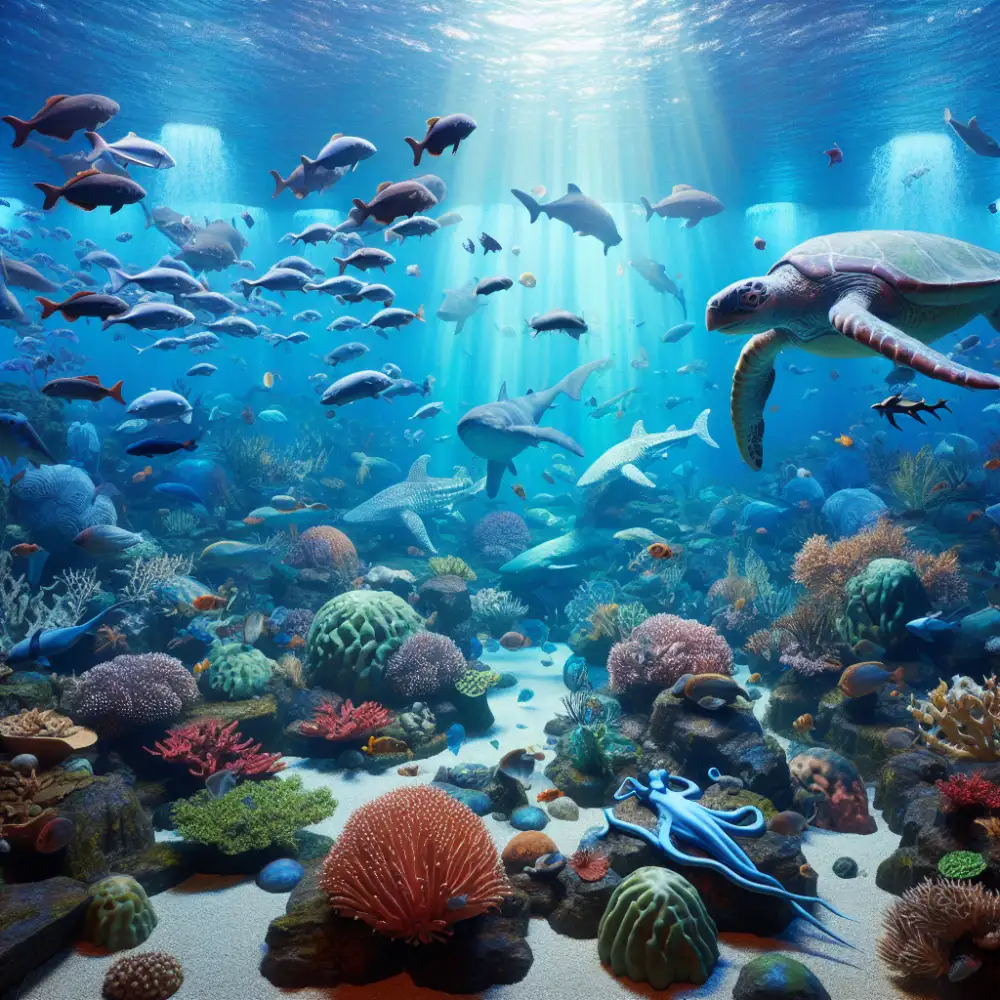
Coping with Pressure: Adaptations to Depth
As one descends into the ocean depths, pressure increases dramatically. Deep-sea creatures have evolved unique adaptations to withstand these extreme conditions. Some have flexible bodies and lack air pockets that would collapse under pressure. Others possess specialized proteins and cellular structures that protect their tissues from the crushing depths.
Camouflage and Mimicry: Blending In and Standing Out
Survival in the ocean often depends on the ability to avoid predators or ambush prey. Many marine animals exhibit remarkable camouflage, blending seamlessly with their surroundings. For example, some fish can change color to match the seafloor or coral reefs, making them nearly invisible to predators or prey. Others have evolved intricate patterns and body shapes that resemble rocks, seaweed, or other inanimate objects.
Venom and Defense: Protection from Predators
The ocean is home to a diverse array of predators and prey, and many marine animals have evolved potent venoms or other defense mechanisms to protect themselves. Jellyfish, for example, have stinging tentacles that deliver venom to paralyze prey or deter attackers. Some fish, like lionfish and stonefish, possess venomous spines that can inflict painful wounds on potential predators.
These adaptations represent just a glimpse into the incredible diversity and ingenuity of life in the ocean. From the streamlined bodies of sharks to the bioluminescent displays of deep-sea creatures, marine animals continue to amaze and inspire us with their ability to thrive in this vast and challenging environment.
| Feature | Free Stock Photo Websites | Paid Stock Photo Websites | Specialized Marine Life Photography Websites |
|---|---|---|---|
| Price | Free | $ - $$ per image or subscription | Varies, can be expensive |
| Image Quality | Variable, often good but can be inconsistent | Generally high quality | Exceptional quality, often award-winning |
| Variety of Species | Moderate, depends on the website | Broad range of species | Highly specialized, focus on specific species or regions |
| Usage Rights | Check license, often requires attribution | Clearly defined usage rights, commercial use usually allowed | Varies, may have restrictions on commercial use |
Threats from human activities
The stunning images of marine life captured by photographers and researchers often mask a darker reality: the many threats these creatures face from human activities. Pollution from coastal development, industrial discharge, and agricultural runoff contaminates their habitats. Plastic waste, a pervasive problem, entangles marine animals, is ingested by them, and leaches harmful chemicals into the water. Climate change, driven by human activities, leads to ocean warming, acidification, and rising sea levels, disrupting marine ecosystems and threatening the survival of countless species. Overfishing, driven by high demand and often employing destructive practices, depletes fish populations faster than they can replenish, impacting entire food webs. Coastal development destroys vital habitats like mangroves, seagrass beds, and coral reefs, which serve as nurseries, feeding grounds, and shelter for a myriad of marine creatures. These threats, often interconnected and amplified by each other, highlight the urgent need for sustainable practices and conservation efforts to protect the beauty and biodiversity of our oceans.
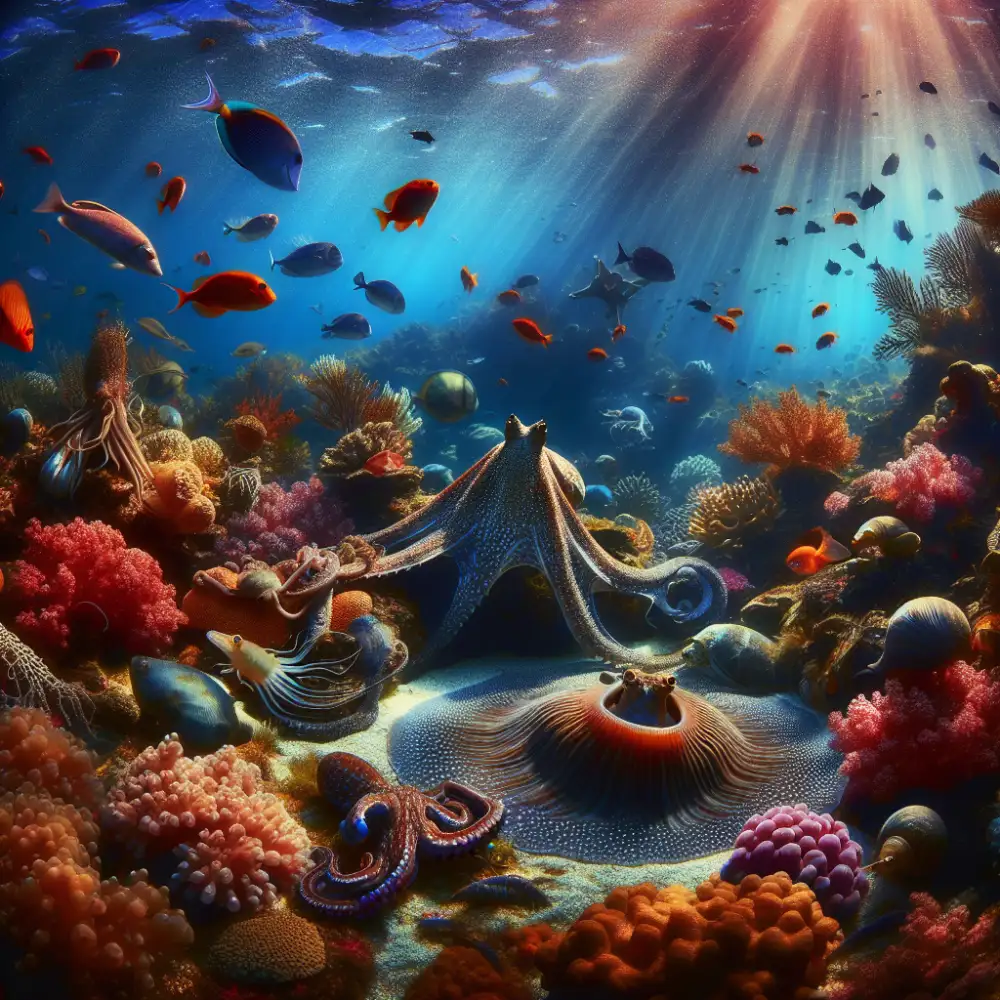
Published: 25. 06. 2024
Category: lifestyle



